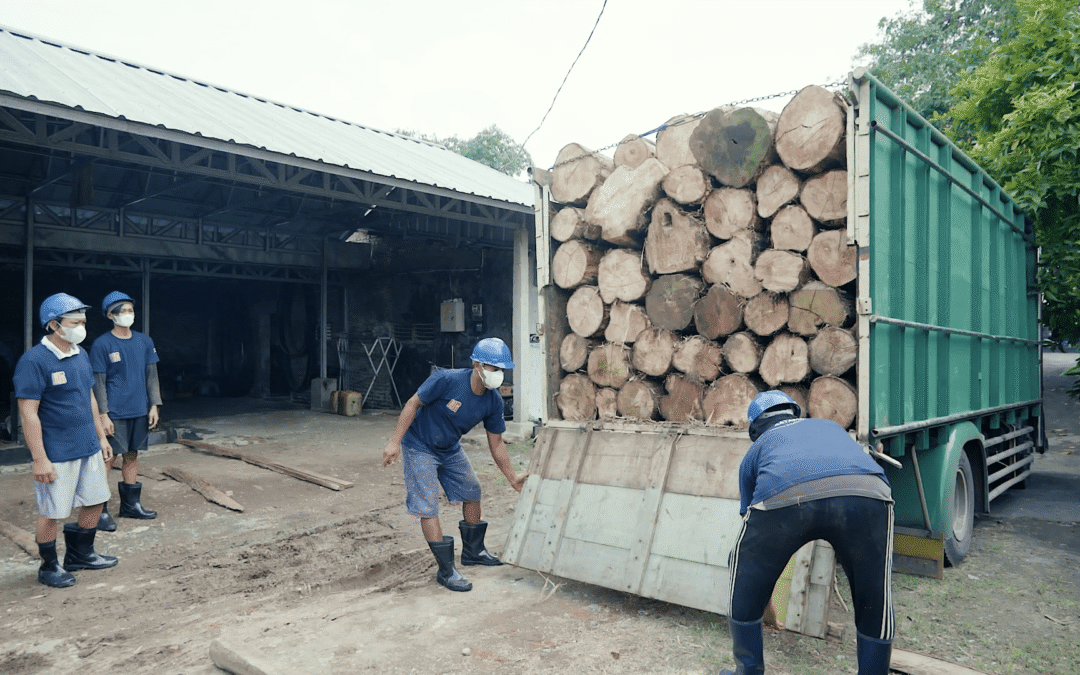Introduction
Unlike teak or mahogany, sungkai is not globally mainstream, but that doesn’t mean it’s inferior. In fact, sungkai offers a balance of affordability, aesthetic appeal, and workability that makes it an attractive option for furniture buyers, especially when produced by a trusted Indonesian furniture manufacturer like MPP Furniture.
From our experience, sungkai wood can even outperform mahogany in several use cases. This is especially true for indoor or semi-outdoor applications, when it’s properly dried, treated, and combined with outdoor-grade components.
This guide will help you understand sungkai wood in depth. You’ll learn its strengths, best applications, and how to make the most of it in your sourcing decision, whether you’re a furniture store retailer, importer, interior designer, wholesaler, or project-based buyer looking for a reliable supply from an Indonesian furniture supplier.
What is Sungkai Wood?
Sungkai wood comes from the Peronema canescens tree, which grows naturally across Sumatra, Java, Kalimantan, and Sulawesi. While not as globally recognized as teak, sungkai is widely used by local Indonesian craftsmen.
Several MPP buyers appreciate sungkai for its attractive grain and more affordable price compared to teak. Some global markets even refer to sungkai as “White Teak” due to its light tone and versatile character (Creatimber).
The wood is known for its light yellowish-brown tones and visible straight grain. It gives a natural, modern look that suits Scandinavian and minimalist interior designs.
Sungkai is a medium-density hardwood, generally weighing between 550 to 650 kg/m³. This makes it strong enough for furniture, yet lighter and easier to work with than teak or oak.
Its popularity has been growing, especially among furniture makers looking for affordable alternatives to premium hardwoods. When treated properly, sungkai can serve well in various indoor and semi-outdoor furniture applications.
Sungkai Wood Characteristics for Furniture
We have been using sungkai wood for over 7 years in various production projects, especially for indoor and semi-outdoor furniture. Based on our experience, here’s how sungkai performs across key aspects:
1. Appearance
Sungkai wood has a naturally smooth texture with a straight and consistent grain. Its bright, warm tone brings out a clean and modern aesthetic.
Many of our buyers choose sungkai for its natural contrast and uniform grain. We often recommend a matte finish to highlight this texture, especially for minimalist collections.
2. Workability
Sungkai is not as heavy or oily as teak, making it easier to machine, sand, and stain.
In our workshop, it’s easier to route and join compared to denser hardwoods. This allows for flexible design, especially in custom or OEM orders.
Worth to read: The Truth About Teak Wood from Indonesia Furniture Supplier
3. Durability
Sungkai is less durable in harsh outdoor settings. Without proper treatment, it may absorb moisture or crack. Scientifically, sungkai has shown moderate natural resistance to drywood termites and powder-post beetles (CABI Compendium).
We avoid exposing sungkai to direct sun and rain. Smart construction like raised legs and airflow gaps helps increase its longevity in semi-outdoor use.
4. Moisture Sensitivity
Proper drying is essential. We kiln-dry sungkai below 12% moisture before production.
Skipping this step often results in cracking, especially after export to humid or temperate climates.
5. Outdoor Compatibility
For semi-outdoor use, we combine sungkai with HDPE weaving, synthetic rope, or quick-dry cushions.
We also avoid flat surfaces that trap water and add drainage design, especially for loungers and tables.
6. Finishing Quality
We use outdoor-rated PU or water-based coatings in multiple layers with sanding in between. A study in MDPI Journal (2023) noted that sungkai demonstrates higher stiffness (storage modulus) than teak in certain mechanical tests, supporting its use in semi-structural applications (Taylor & Francis).
This helps prevent moisture buildup and extends durability for 1–2 years in shaded outdoor settings like patios or balconies.
Sungkai Wood vs Teak, Mahogany, and Mindi
To help you compare sungkai with other popular Indonesian hardwoods, here is a table that summarizes key characteristics:
| Characteristic | Sungkai | Teak | Mahogany | Mindi |
| Density (kg/m³) | 550–650 | 650–800+ | 450–600 | 450–600 |
| Appearance | Light, straight grain | Golden brown, oily texture | Reddish brown, fine grain | Pale yellow, subtle grain |
| Workability | Easy to machine and finish | Harder, needs sharp tools | Moderate, easy to carve | Easy to machine and glue |
| Durability (Outdoor) | Moderate (semi-outdoor) | Excellent (fully outdoor) | Moderate to low | Low (indoor only) |
| Moisture Sensitivity | Requires kiln-drying | Naturally resistant | Needs treatment | Sensitive, must be dried |
| Cost | Affordable | High | Mid to high | Affordable |
Best Furniture Made from Sungkai Wood
- Sungkai Wood Chairs: Lightweight yet sturdy, ideal for dining or lounge settings.
- Dining Tables: Sungkai’s consistent grain makes for elegant, contemporary surfaces.
- Cabinets and Storage Units: Its light tone brightens interior spaces.
Where It Works Best
- Indoor Spaces: Living rooms, dining rooms, office settings.
- Semi-Outdoor Areas: Covered patios, terraces, and balconies.
Many Indonesian furniture manufacturers, including MPP Furniture, use sungkai for OEM and private-label production, offering modern designs with flexible customization, especially for covered outdoor or indoor use.
Advantages vs Disadvantages of Sungkai Wood Furniture
Advantages
- Attractive appearance: Light color and straight grain suit modern interiors.
- Easy to work with: Great for custom and OEM designs.
- Affordable: Less expensive than teak or imported hardwoods.
- Lightweight: Easier to handle and ship.
- Versatile: Suitable for both indoor and semi-outdoor use when treated properly.
Disadvantages
- Not ideal for full outdoor use: Needs cover from direct rain and sun.
- Moisture-sensitive: Must be kiln-dried and sealed well.
- Moderate durability: Not as long-lasting as teak in harsh conditions.
Why Choose MPP Furniture as Your Indonesian Furniture Manufacturer
MPP is more than just an Indonesian furniture manufacturer. We’re a full-service furniture Indonesia factory offering tailored solutions for retailers, wholesalers, and project-based buyers worldwide.
Here’s why buyers trust us:
✅ Full in-house production: From kiln-drying, CNC, sanding, assembly, to finishing.
✅ Specialization in sungkai: More than 7 years of experience producing sungkai wood furniture.
✅ Custom and OEM support: We help retailers and project buyers build exclusive designs.
✅ Free product development: Test new designs without extra development fees.
✅ Export-ready operations: Strong quality control and packaging for global shipments.
✅ Trusted by global buyers: Serving clients in the US, Spain, UAE, Australia, and more.
Worth to read: How To Choose The Best Indonesian Furniture Manufacturer for Export
Conclusion: Why MPP Furniture Is Your Ideal Indonesian Supplier
Sungkai wood is an underrated gem for furniture buyers who want style, flexibility, and value. With proper treatment and the right production approach, it can rival more expensive hardwoods.
📌 Ready to Get Started?
Let’s build your next best-selling sungkai furniture line together:
✅ Request custom designs or private label offers
✅ Get expert input on product development
✅ Tap into one-stop sourcing with full in-house quality control
👉 Contact MPP Furniture or schedule your consultation or directly contact us via Whatsapp
👉 Connect with Salman on LinkedIn, follow MPP on LinkedIn, or watch our company intro video.
Let’s talk about how Indonesian sungkai wood can work for your market.
FAQs
Is sungkai wood good quality? Yes. Sungkai offers moderate durability, a clean appearance, and works well when dried and finished properly for indoor or semi-outdoor use.
What is the color of sungkai wood? It ranges from light yellowish-brown to medium brown, with a straight and often striking grain.
Can sungkai be used for outdoor furniture? Not for fully exposed areas, but it performs well under cover with outdoor-grade finishing and components.
Where does sungkai wood come from? It is native to Indonesia and commonly grown in Sumatra, Java, and Kalimantan.
Why choose an Indonesian furniture manufacturer? Indonesia is known for its craftsmanship, sustainable wood sourcing, and competitive pricing, especially when working with a partner like MPP Furniture.
References
The insights above are supported by global studies and institutional sources, reinforcing the potential of sungkai wood for the international B2B furniture market.

